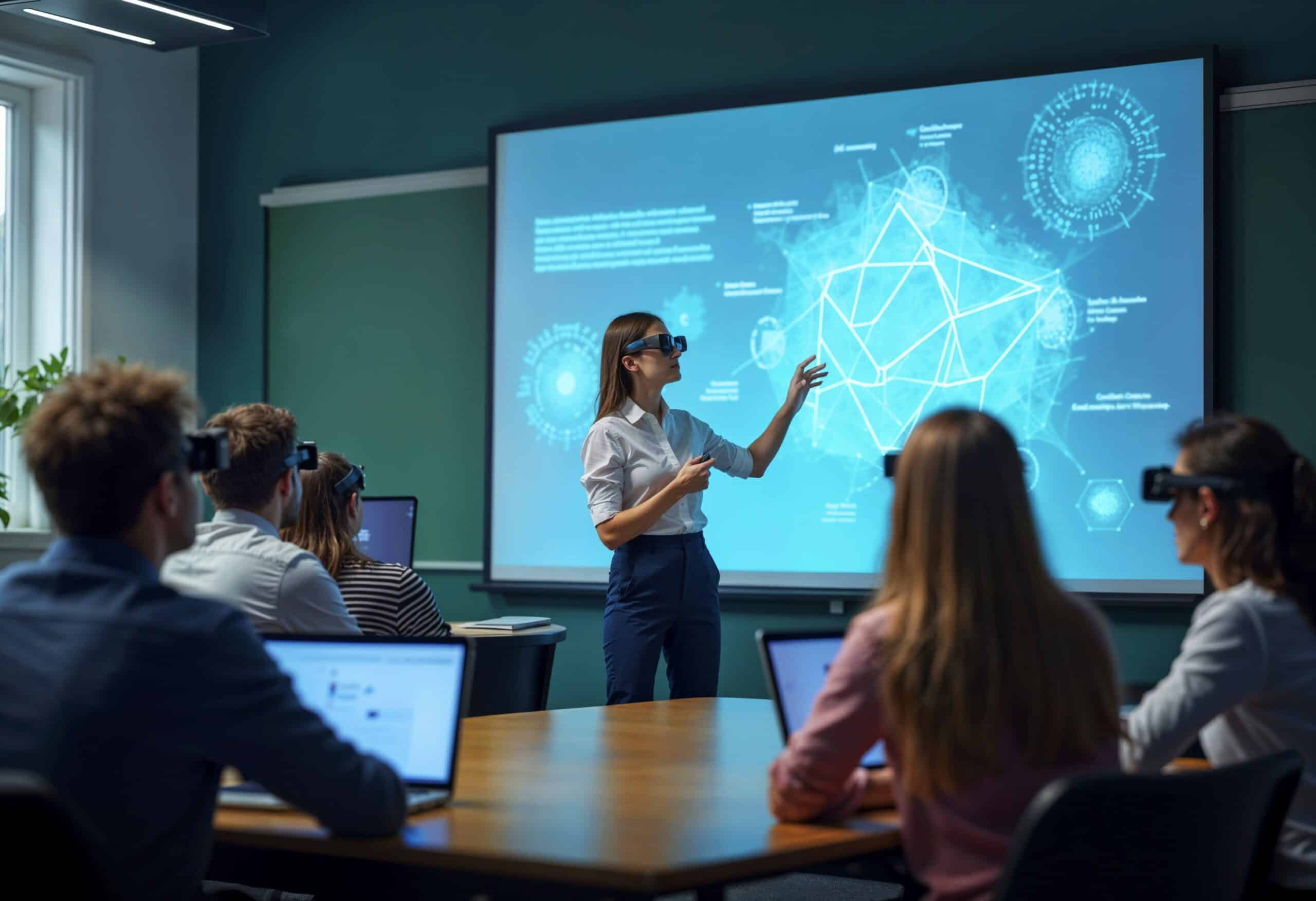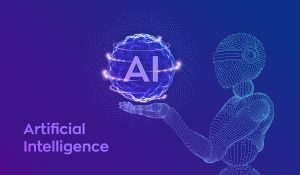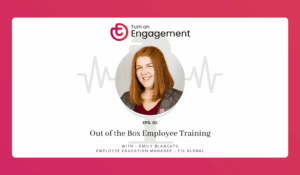The modern workplace has fundamentally shifted, and employee training stands at the center of this transformation. Companies that prioritize comprehensive employee training programs report 218% higher revenue per employee compared to those without structured development initiatives. Furthermore, organizations investing in strategic employee training see 30% higher engagement rates and significantly reduced turnover costs.
Today’s workforce demands more than traditional classroom sessions and outdated manuals. Instead, successful businesses are reimagining employee training through personalized, technology-driven approaches that align with actual workplace challenges. Moreover, the companies winning in today’s competitive landscape understand that effective employee training isn’t just about compliance, it’s about creating adaptable, skilled teams ready for tomorrow’s challenges.
The stakes couldn’t be higher. 90% of companies have employee retention as one of their concerns and their top retention strategy is offering learning opportunities to employees. Therefore, strategic employee training has become the differentiator between thriving organizations and those struggling to maintain their workforce.
What Employee Training Really Means in Today’s Workplace
Employee training encompasses the systematic process of equipping workers with job-specific skills, knowledge, and competencies needed to perform effectively in their current roles while preparing them for future responsibilities. Unlike generic education programs, workplace-focused employee training directly addresses organizational needs, industry requirements, and individual career development goals.
However, many organizations still confuse activity with achievement. Simply conducting training sessions doesn’t guarantee effective employee training. Instead, successful programs integrate learning with daily workflows, provide immediate application opportunities, and measure concrete business outcomes.
The most impactful employee training programs share common characteristics: they’re relevant to actual work situations, accessible when employees need them, and designed around specific performance gaps rather than generic skill categories. Additionally, effective training creates measurable improvements in productivity, quality, and employee satisfaction within the organization.
The Employee Training Process That Drives Results
Old Approach: One-Size-Fits-All Training Programs
Traditional employee training followed a rigid, standardized model. Companies would schedule quarterly training sessions, covering broad topics irrelevant to many attendees. Consequently, engagement remained low, knowledge retention suffered, and business impact was negligible.
These outdated programs typically featured:
- Generic content that didn’t address specific job requirements
- Inflexible scheduling that disrupted daily operations
- Limited follow-up or reinforcement activities
- No connection between training content and performance metrics
- Passive learning methods that failed to engage participants
Modern Workplace Approach: Personalized Development Pathways
Today’s most successful employee training programs take a radically different approach. 77% of employees say personalized training increases their engagement and learning retention. Therefore, organizations are shifting toward individualized learning experiences that adapt to each worker’s role, skill level, and career aspirations.
Modern employee training processes include:
- Assessment Phase: Identifying specific skill gaps through performance reviews, competency assessments, and job requirement analysis
- Customization Phase: Creating personalized learning paths that address individual needs while supporting organizational objectives
- Implementation Phase: Delivering training through multiple channels including mobile apps, microlearning modules, and peer collaboration
- Application Phase: Providing immediate opportunities to practice new skills in real work situations
- Evaluation Phase: Measuring both learning outcomes and business impact through comprehensive analytics
This approach ensures employee training delivers tangible value rather than consuming time without generating results. Furthermore, personalized training creates stronger emotional connections between employees and their development, leading to better retention and application of new skills.
Who Needs Employee Training: Breaking Down Organizational Requirements
New Hires and Onboarding Success
Every new employee requires comprehensive training regardless of their experience level. Poor onboarding costs 30-50% of an employee’s annual salary, making effective new hire training crucial for organizational success. Moreover, employees who experience structured onboarding are 58% more likely to remain with the company after three years.
New hire employee training should cover:
- Company culture, values, and expectations
- Role-specific skills and responsibilities
- Safety protocols and compliance requirements
- Technology systems and workflow processes
- Performance standards and evaluation criteria
Existing Employees and Skill Development
Current employees need ongoing training to maintain effectiveness and adapt to changing business requirements. Job-related learning activities reduce stress by 47% and increase productivity by 39%. Therefore, continuous employee training becomes essential for both individual satisfaction and organizational performance.
Ongoing employee training addresses:
- Technology updates and new system implementations
- Process improvements and workflow changes
- Industry regulations and compliance updates
- Leadership development and career advancement
- Cross-training for operational flexibility
Leadership Teams and Management Development
Managers and supervisors require specialized employee training focused on people management, strategic thinking, and organizational leadership. Since 70% of employee engagement depends on immediate supervisors, investing in management training creates cascading positive effects throughout the organization.
Leadership employee training encompasses:
- Communication and feedback techniques
- Performance management and coaching skills
- Conflict resolution and problem-solving
- Strategic planning and decision-making
- Change management and adaptability
Building resilience in the workplace through leadership training helps managers support their teams during challenging periods while maintaining productivity and morale.
The Manager’s Role in Employee Training Success
Traditional Manager Involvement: Passive Oversight
Historically, managers played minimal roles in employee training beyond approving attendance and budgets. This disconnect meant training programs operated independently from daily work requirements, reducing their effectiveness and application.
Modern Manager Engagement: Active Partnership
Today’s most successful employee training programs position managers as active partners in the development process. Research shows that employees whose managers actively support their learning are 5x more likely to apply new skills effectively.
Effective managers in employee training:
- Identify Training Needs: Regularly assess team performance to pinpoint specific skill gaps and development opportunities
- Provide Context: Connect training content to actual work challenges and organizational goals
- Support Application: Create opportunities for employees to practice new skills in safe environments
- Offer Feedback: Provide ongoing coaching and reinforcement to ensure skill retention and improvement
- Model Learning: Demonstrate commitment to continuous development through their own training participation
Managers also play crucial roles in creating psychological safety where employees feel comfortable asking questions, making mistakes, and experimenting with new approaches. This environment significantly improves training effectiveness and knowledge retention.
Furthermore, managers serve as bridges between formal training programs and practical application. They help employees translate generic concepts into specific actions relevant to their roles and responsibilities. Additionally, effective managers recognize and celebrate training achievements, reinforcing the value of continuous learning.
HR’s Strategic Role in Employee Training Excellence
What HR Brings to Employee Training
Human Resources departments serve as the strategic architects of effective employee training programs. Unlike operational departments that focus on immediate productivity, HR takes a comprehensive view of workforce development aligned with long-term organizational objectives.
HR responsibilities in employee training include:
- Strategic Planning: Aligning training initiatives with business goals, succession planning, and organizational capability requirements
- Needs Assessment: Conducting systematic analyses to identify skill gaps across departments and job levels
- Program Design: Creating comprehensive training curricula that address both immediate needs and future requirements
- Vendor Management: Selecting and managing relationships with external training providers and technology platforms
- Compliance Oversight: Ensuring all training meets regulatory requirements and industry standards
Challenges HR Faces in Workplace Training Implementation
Despite their strategic importance, HR departments encounter significant obstacles when implementing effective employee training programs. HR needs to focus again on taking care of workers and persuade management to change outdated policies on compensation, training and development.
Common challenges include:
- Budget Constraints: Securing adequate funding for comprehensive training programs while demonstrating clear ROI
- Time Management: Balancing training needs with operational demands and productivity requirements
- Technology Integration: Selecting and implementing platforms that work with existing systems and workflows
- Change Resistance: Overcoming skepticism from managers and employees who view training as time away from “real work”
- Measurement Difficulties: Establishing metrics that accurately capture training effectiveness and business impact
HR Solutions for Modern Training Success
Progressive HR departments overcome these challenges through strategic approaches that emphasize business value and measurable outcomes. Successful HR teams focus on creating integrated training ecosystems rather than standalone programs.
Effective HR strategies include:
- Business Case Development: Presenting training investments in terms of productivity gains, retention savings, and competitive advantages
- Stakeholder Engagement: Building coalitions with department heads and senior leadership to champion training initiatives
- Technology Leverage: Implementing AI Powered Workplaces solutions that automate administrative tasks and personalize learning experiences
- Data-Driven Decisions: Using analytics to track training effectiveness and continuously improve program design
- Culture Integration: Embedding learning into organizational values and recognition systems
HR departments also coordinate with internal communication tool systems to ensure training information reaches all employees effectively. This coordination includes creating awareness campaigns, sharing success stories, and maintaining ongoing dialogue about development opportunities.
Employee Training Types That Transform Workplace Performance
Technical Skills Training
Technical employee training focuses on job-specific competencies required for role effectiveness. This includes software proficiency, equipment operation, industry-specific knowledge, and process execution. Moreover, technical training directly impacts productivity, quality, and safety metrics.
Effective technical training programs:
- Use hands-on practice with actual work tools and systems
- Provide step-by-step guidance for complex procedures
- Include troubleshooting and problem-solving scenarios
- Offer multiple practice opportunities before performance evaluation
- Connect technical skills to broader business objectives
Soft Skills Development
While technical skills get employees hired, soft skills determine their success and advancement potential. Communication, teamwork, leadership, and emotional intelligence significantly impact workplace relationships and overall effectiveness.
Critical soft skills training includes:
- Communication Excellence: Written and verbal communication, active listening, and presentation skills
- Collaboration Techniques: Team dynamics, conflict resolution, and cross-functional cooperation
- Problem-Solving Methods: Critical thinking, creative solutions, and decision-making processes
- Time Management: Prioritization, delegation, and productivity optimization
- Adaptability Skills: Change management, stress resilience, and continuous learning mindsets
Compliance and Safety Training
Regulatory compliance training protects both employees and organizations from legal liabilities while ensuring safe working conditions. This type of employee training requires regular updates to reflect changing regulations and industry standards.
Comprehensive compliance training covers:
- Workplace safety protocols and emergency procedures
- Industry-specific regulatory requirements
- Data privacy and security standards
- Harassment prevention and diversity awareness
- Environmental protection and sustainability practices
Leadership Development Programs
Leadership training prepares high-potential employees for increased responsibilities while strengthening the overall management pipeline. HR managers’ functions in 2024 should include designing and implementing effective policies for workplace diversity and inclusion.
Effective leadership development includes:
- Strategic thinking and business acumen
- Team building and motivation techniques
- Performance management and coaching skills
- Change leadership and innovation promotion
- Ethical decision-making and integrity standards
The Training Process: From Identification to Implementation
Step 1: Needs Assessment and Gap Analysis
Successful employee training begins with thorough analysis of current capabilities versus desired performance levels. This assessment involves multiple data sources including performance reviews, customer feedback, operational metrics, and employee surveys.
Key assessment activities include:
- Performance Analysis: Reviewing individual and team performance data to identify specific skill deficiencies
- Job Analysis: Examining role requirements to ensure training aligns with actual job demands
- Future Planning: Considering organizational changes and growth plans that will require new capabilities
- Stakeholder Input: Gathering perspectives from managers, employees, and customers about training needs
- Competitive Analysis: Benchmarking against industry standards and best practices
Step 2: Learning Objectives and Success Metrics
Clear, measurable learning objectives guide effective employee training design and evaluation. Objectives should specify what employees will be able to do differently after completing training, not just what they will know.
Effective objectives follow the SMART framework:
- Specific: Clearly defined behaviors or skills
- Measurable: Quantifiable performance indicators
- Achievable: Realistic given time and resource constraints
- Relevant: Connected to actual job requirements
- Time-bound: Specific deadlines for achievement
Step 3: Content Development and Delivery Method Selection
Modern employee training utilizes multiple delivery methods to accommodate different learning styles and operational constraints. 33.23% of respondents indicated plans to invest in AI tools, reflecting the growing importance of automation and machine learning in recruitment processes.
Delivery options include:
- Microlearning Modules: Short, focused sessions that fit into busy schedules
- Interactive Simulations: Safe environments for practicing high-risk or expensive procedures
- Peer Learning Programs: Collaborative sessions that leverage internal expertise
- Mobile Learning Apps: Accessible training that employees can complete anywhere
- Blended Approaches: Combinations of online and in-person training for optimal effectiveness
Step 4: Implementation and Rollout Strategy
Strategic implementation ensures maximum participation and minimal operational disruption. Successful rollouts consider timing, communication, and support systems needed for training success.
Implementation considerations include:
- Pilot Testing: Small-scale trials to identify and resolve issues before full deployment
- Communication Planning: Clear messaging about training importance, expectations, and benefits
- Schedule Coordination: Timing that minimizes productivity impacts while ensuring attendance
- Technical Support: Help desk services and troubleshooting resources for technology-based training
- Manager Preparation: Training supervisors to support and reinforce learning initiatives
Step 5: Evaluation and Continuous Improvement
Comprehensive evaluation measures both learning outcomes and business impact to ensure employee training delivers value. Evaluation should occur at multiple levels and time points to capture both immediate and long-term effects.
Evaluation levels include:
- Reaction Assessment: Participant satisfaction and engagement with training content
- Learning Measurement: Knowledge and skill acquisition verification
- Behavior Change: Application of new skills in actual work situations
- Business Impact: Organizational results including productivity, quality, and financial metrics
- Return on Investment: Cost-benefit analysis of training program effectiveness
Measuring Employee Training Success: Metrics That Matter
Traditional Training Metrics: Activity-Based Measurement
Many organizations still measure employee training success through activity metrics such as attendance rates, course completion percentages, and satisfaction scores. While these indicators provide basic insights, they don’t reveal whether training actually improves performance or delivers business value.
Common activity metrics include:
- Number of employees trained
- Hours of training delivered
- Course completion rates
- Participant satisfaction scores
- Training cost per employee
Modern Training Metrics: Outcome-Based Evaluation
Successful organizations focus on outcome metrics that directly connect employee training to business results. 80% of employees who report receiving meaningful feedback in the past week are fully engaged in the work they do. This approach provides clearer insights into training effectiveness and ROI.
Critical outcome metrics include:
- Performance Improvement: Measurable increases in individual and team productivity
- Quality Enhancement: Reduction in errors, defects, or customer complaints
- Retention Impact: Decreased turnover rates among trained employees
- Engagement Scores: Improved employee satisfaction and commitment levels
- Revenue Growth: Increased sales, efficiency, or profitability attributable to training
Advanced Analytics for Training Optimization
Modern employee training programs leverage advanced analytics to continuously improve effectiveness and relevance. Data-driven insights help organizations identify what works, what doesn’t, and how to optimize future training investments.
Analytics capabilities include:
- Learning Path Analysis: Tracking which training sequences produce the best outcomes
- Skill Gap Prediction: Identifying future training needs based on business trends
- Personalization Effectiveness: Measuring how customized training impacts individual performance
- Cost Optimization: Determining the most efficient training delivery methods and formats
- Predictive Modeling: Using historical data to forecast training needs and resource requirements
Building a Culture of Continuous Learning
From Training Events to Learning Culture
Traditional approaches treated employee training as discrete events disconnected from daily work. However, organizations with strong learning cultures integrate development into the fabric of their operations, creating environments where continuous improvement becomes natural and expected.
Cultural transformation requires:
- Leadership Commitment: Visible support and participation from senior management
- Time Allocation: Dedicated time for learning without productivity pressure
- Resource Investment: Adequate budgets for training technology, content, and facilitation
- Recognition Systems: Celebrating and rewarding learning achievements and application
- Knowledge Sharing: Platforms and processes for employees to share insights and experiences
Building resilience in the workplace through learning culture helps organizations adapt quickly to market changes while maintaining employee engagement and satisfaction.
HubEngage’s Communications Hub ensures learning opportunities and success stories are consistently shared across all channels, embedding development into daily organizational conversations. The platform’s automated milestone celebrations through the Recognition Hub make continuous learning visible and valued company-wide.
Creating Learning-Friendly Environments
Physical and virtual environments significantly impact learning effectiveness and retention. Organizations should design spaces and systems that support both formal training and informal knowledge sharing.
Environmental considerations include:
- Physical Spaces: Comfortable, technology-enabled rooms for collaborative learning
- Digital Platforms: User-friendly systems for accessing training content and resources
- Social Networks: Intranet communications tools that facilitate peer learning and mentorship
- Mobile Accessibility: Training available on smartphones and tablets for flexible learning
- Quiet Spaces: Areas where employees can focus on individual learning activities
HubEngage’s Social Hub provides digital spaces for peer learning and knowledge sharing that complement physical training environments. The platform’s mobile accessibility ensures learning resources are available anywhere, creating flexible learning environments that adapt to modern work styles.
Overcoming Learning Barriers
Despite good intentions, many employee training initiatives fail due to common organizational barriers. Identifying and addressing these obstacles proactively increases training success rates and employee participation.
Common barriers include:
- Time Constraints: Employees feeling too busy for training activities
- Relevance Questions: Unclear connections between training content and job requirements
- Technology Challenges: Difficult-to-use systems that frustrate rather than enable learning
- Manager Resistance: Supervisors who view training as productivity loss rather than investment
- Culture Conflicts: Organizational values that prioritize immediate results over long-term development
Successful organizations address these barriers through clear communication, supportive policies, and systems designed for ease of use and maximum relevance.
HubEngage’s AI-powered personalization delivers relevant training communications that clearly connect to individual job requirements, addressing relevance concerns. The platform’s user-friendly interface and automated support features eliminate technology barriers that often frustrate employees and reduce training participation.
Technology’s Role in Modern Employee Training
AI-Powered Learning Platforms
Artificial intelligence is revolutionizing employee training through personalized experiences and intelligent content delivery. AI Powered Workplaces can analyze individual learning patterns, recommend relevant content, and adapt training pathways based on performance and preferences.
AI capabilities in training include:
- Content Personalization: Customizing training materials based on role, skill level, and learning style
- Intelligent Tutoring: Providing real-time guidance and support during learning activities
- Performance Prediction: Identifying employees at risk of training failure before it occurs
- Automated Assessment: Evaluating skill levels and progress without manual intervention
- Natural Language Processing: Enabling conversational interfaces for training questions and support
HubEngage’s AI content generation creates personalized training communications and automated reminders that adapt to individual learning patterns and preferences. The platform’s intelligent analytics predict training needs and engagement levels, helping organizations optimize their development programs proactively.
Mobile Learning Revolution
Smartphone and tablet adoption has made mobile learning essential for effective employee training. Mobile platforms provide flexibility and accessibility that traditional classroom training cannot match, particularly for distributed or remote workforces.
Mobile learning advantages include:
- Anywhere Access: Training available during commutes, breaks, or off-site work
- Microlearning Support: Short modules that fit naturally into mobile consumption patterns
- Just-in-Time Learning: Immediate access to information when employees need it most
- Social Learning Features: Collaboration tools that work across devices and locations
- Offline Capability: Downloadable content for areas with limited internet connectivity
HubEngage’s mobile-first design provides seamless access to training updates, peer collaboration, and recognition features across all devices and locations. The platform’s offline capability ensures training communications and resources remain accessible even in areas with limited internet connectivity.
Virtual and Augmented Reality Training
Immersive technologies create safe, controlled environments for practicing dangerous, expensive, or rare procedures. VR and AR training provides realistic experiences without real-world risks or costs.
Immersive training applications include:
- Safety Simulations: Practicing emergency procedures without actual danger
- Equipment Training: Learning complex machinery operation before handling expensive equipment
- Soft Skills Practice: Role-playing difficult conversations or presentations in virtual environments
- Remote Collaboration: Team training for geographically distributed employees
- Historical Recreation: Experiencing company history or industry evolution firsthand
HubEngage integrates with VR/AR training platforms while providing the communication and recognition infrastructure needed to support immersive learning experiences. The platform’s multi-channel reach ensures employees receive proper preparation and follow-up communications for complex virtual training sessions.
Ways to Reward Employees Through Training Recognition
Gamification and Achievement Systems
Modern employee training programs incorporate game-like elements to increase engagement and motivation. Ways to reward employees through gamified learning create positive associations with professional development while encouraging continued participation.
Effective gamification includes:
- Progress Tracking: Visual indicators showing advancement through training programs
- Badge Systems: Digital recognition for completing specific training milestones
- Leaderboards: Friendly competition that motivates continued learning
- Achievement Unlocks: New training opportunities earned through previous success
- Team Challenges: Collaborative goals that build camaraderie while advancing skills
HubEngage’s Recognition Hub creates comprehensive badge systems, leaderboards, and progress tracking that transform training completion into engaging, competitive experiences. The platform’s automated achievement unlocks and team challenges build camaraderie while motivating continued learning participation.
Career Development Pathways
Training programs become powerful ways to reward employees when directly connected to advancement opportunities and career growth. Clear pathways from training completion to promotion or increased responsibility demonstrate organizational investment in individual success.
Career-connected training includes:
- Succession Planning: Preparing high-potential employees for leadership roles
- Skill Certification: Industry-recognized credentials earned through internal training
- Cross-Training Opportunities: Exposure to different departments or functions
- Mentorship Programs: Pairing experienced employees with developing talent
- Innovation Projects: Opportunities to apply new skills in high-visibility initiatives
HubEngage’s communication tools help HR and managers clearly connect training completion to advancement opportunities through targeted messaging and career pathway announcements. The platform’s recognition features publicly celebrate skill certifications and training achievements that support promotion and career growth.
Recognition and Celebration
Public acknowledgment of training achievements reinforces the value of continuous learning while motivating others to participate. Recognition should be timely, specific, and meaningful to the individuals being celebrated.
Recognition strategies include:
- Completion Ceremonies: Formal acknowledgment of training program graduates
- Internal Communications: Sharing training success stories through company newsletters and meetings
- Peer Nominations: Allowing colleagues to recognize exceptional training application
- Manager Appreciation: Training supervisors to acknowledge and celebrate team learning
- Awards Programs: Formal recognition for outstanding training participation or application
HubEngage automates training completion ceremonies and success story sharing through its Communications Hub, ensuring achievements receive timely, company-wide recognition. The platform’s peer nomination features and manager appreciation tools create multiple touchpoints for acknowledging exceptional training application and results.
Trends in Employee Engagement Through Strategic Training
Personalization and Individual Focus
Current trends in employee engagement emphasize personalized experiences that recognize individual preferences, learning styles, and career aspirations. Generic, one-size-fits-all training programs are giving way to customized approaches that adapt to each employee’s unique situation.
Personalization trends include:
- Adaptive Learning Paths: Training sequences that adjust based on individual progress and performance
- Choice Architecture: Allowing employees to select from multiple training options that meet the same objectives
- Individual Coaching: One-on-one support that addresses specific challenges and goals
- Flexible Scheduling: Training available when employees are most ready and able to learn
- Multi-Modal Delivery: Options for visual, auditory, kinesthetic, and reading-based learning preferences
Social Learning and Peer Collaboration
Social learning represents a major shift in trends in employee engagement, recognizing that people learn effectively from colleagues and peers. Organizations are creating structured opportunities for knowledge sharing and collaborative skill development.
Social learning initiatives include:
- Communities of Practice: Groups organized around specific skills or interests
- Peer Mentoring: Experienced employees guiding less experienced colleagues
- Knowledge Sharing Sessions: Regular opportunities for employees to teach each other
- Collaborative Projects: Team-based learning through real work challenges
- Discussion Forums: Online spaces for ongoing conversation about training topics
Continuous Learning Integration
Rather than treating training as separate events, current trends in employee engagement integrate learning into daily workflows and regular activities. This approach makes skill development a natural part of work rather than an additional burden.
Integration strategies include:
- Learning Sprints: Short, intensive periods focused on specific skill development
- Reflection Time: Built-in periods for processing and applying new knowledge
- Action Learning: Solving real business problems while developing new capabilities
- Stretch Assignments: Projects that require employees to use and expand their skills
- Learning Circles: Regular team meetings focused on skill sharing and development
Talent Development Through Comprehensive Training Programs
Strategic Workforce Planning
Effective talent development requires alignment between current training initiatives and future organizational needs. Strategic planning ensures training investments prepare employees for tomorrow’s challenges while addressing today’s performance requirements.
Strategic elements include:
- Skills Forecasting: Predicting future capability requirements based on business strategy
- Gap Analysis: Identifying differences between current and needed competencies
- Succession Planning: Preparing internal candidates for key leadership positions
- Capability Building: Developing organizational strengths in critical areas
- Competitive Advantage: Using training to differentiate from competitors
Individual Development Planning
Personalized talent development plans align individual career aspirations with organizational needs, creating win-win scenarios that benefit both employees and employers. These plans provide clear roadmaps for professional growth while ensuring business requirements are met.
Development planning includes:
- Career Conversations: Regular discussions between managers and employees about growth opportunities
- Skill Assessments: Objective evaluations of current capabilities and development needs
- Goal Setting: Specific, measurable objectives for skill development and career advancement
- Resource Allocation: Identifying training, mentoring, and experience opportunities
- Progress Reviews: Regular check-ins to adjust plans based on changing needs and interests
High-Potential Employee Programs
Specialized talent development programs for high-performing employees accelerate their growth while increasing retention of valuable team members. These programs typically offer enhanced learning opportunities, increased responsibilities, and clear advancement pathways.
High-potential programs include:
- Leadership Accelerators: Intensive development experiences for future leaders
- Cross-Functional Rotations: Exposure to different areas of the business
- Executive Mentoring: Pairing rising stars with senior leadership
- Special Projects: Opportunities to lead significant initiatives
- External Development: Industry conferences, advanced education, and professional networking
Why HubEngage Represents the Future of Employee Training
Comprehensive Platform Integration
When organizations seek to implement these modern training strategies, HubEngage provides a unified solution that addresses all aspects of employee development and engagement. Unlike fragmented systems requiring multiple vendors and complex integrations, HubEngage combines essential training support tools in one comprehensive platform designed specifically for contemporary workplace needs.
HubEngage’s integrated approach includes specialized hubs that directly support effective employee training: the Communications Hub ensures training announcements and updates reach all employees through multiple channels, the Recognition Hub celebrates learning achievements and milestones, the Social Hub facilitates peer collaboration and knowledge sharing, and the Survey Hub gathers continuous feedback about training effectiveness and needs. Moreover, the platform’s AI-powered features automate content creation, provide real-time translations for diverse workforces, and deliver actionable insights that help training administrators optimize program effectiveness continuously.
The platform’s one-click multi-channel reach ensures training materials and communications reach employees across mobile apps, web portals, email, SMS, and digital signage, eliminating the common problem of employees missing critical training information. Furthermore, the gamified recognition system naturally reinforces training participation and achievement, creating positive associations with professional development that increase long-term engagement and retention.
Measurable Results and ROI
HubEngage delivers quantifiable improvements that directly impact organizational performance and training effectiveness. Companies implementing HubEngage’s comprehensive employee training support system report 30% higher engagement rates, 20% reduction in administrative time, and significantly improved employee retention compared to organizations using traditional, fragmented approaches. These results demonstrate clear return on investment from day one through streamlined processes, automated workflows, and comprehensive analytics that track both learning outcomes and business impact.
The platform’s advanced analytics capabilities provide detailed insights into training program effectiveness, participant engagement, and skill application rates. Additionally, real-time dashboards help training administrators identify trends, optimize content delivery, and demonstrate concrete business value to senior leadership. Therefore, organizations can confidently invest in employee training knowing they have the tools and data needed to ensure success and continuous improvement.
Conclusion: Transform Your Organization Through Strategic Employee Training
The future of work demands better training solutions, and the organizations that invest in comprehensive, technology-enabled employee training programs position themselves for sustained competitive advantage. Furthermore, employees increasingly expect meaningful development opportunities, making strategic training essential for attraction and retention of top talent.
Modern employee training isn’t about checking compliance boxes or filling time with generic content. Instead, it’s about creating personalized, engaging experiences that directly improve performance while supporting individual career aspirations. Moreover, the most successful organizations understand that employee training serves as the foundation for innovation, adaptability, and long-term growth.
The time for incremental improvements has passed. Organizations need comprehensive solutions that integrate training with communication, recognition, and engagement to create holistic development experiences. Therefore, investing in platforms like HubEngage that provide unified training support while delivering measurable results becomes essential for forward-thinking businesses.
Your employees deserve development opportunities that respect their time, address their actual needs, and support their professional growth. Your organization demands training programs that deliver concrete business value through improved performance, increased engagement, and stronger retention. HubEngage provides the comprehensive platform needed to achieve both goals simultaneously.
Don’t let outdated training approaches limit your organization’s potential. Connect with HubEngage today to transform your employee training into a strategic advantage that drives both individual success and organizational excellence.








